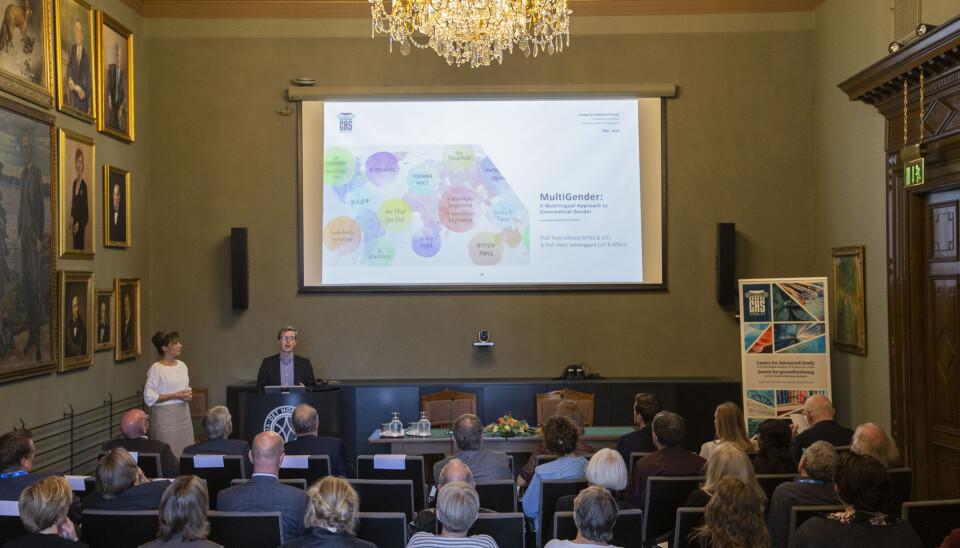This article is produced and financed by The Centre for Advanced Study (CAS) - read more

Do we really need grammatical gender?
Half of the world’s languages manage without this grammatical category. For non-native speakers it may be almost impossible to fully learn. So what is it good for?
This story is about gender.
Not feminism and equality, but grammatical gender.
Many languages have this system of organising nouns into different classes, but equally many manage without it.
In some languages, gender signifies biological sex, whilst in other languages the meaning of a noun is irrelevant for its gender. Why do some languages manage without this, often intricate, system, whilst speakers of Norwegian, for instance, must learn the nouns’ genders item by item?
Marit Westergaard and Terje Lohndal want to understand the representation of grammatical gender in the human mind. Core questions are how grammatical gender is acquired and how it may change across time? They found that CAS was the right arena for their research project and moved from Tromsø and Trondheim respectively to stay at CAS for one year with national and international experts on grammatical gender, working on many different languages.
"We also try to figure out whether gender systems across the world are fundamentally the same, as people have believed in the past, or perhaps they are more different than we think", Lohndal says.
So far, they believe the latter is more likely.

Most puzzling grammatical category
“Gender is the most puzzling of the grammatical categories”, Greville Corbett (currently a CAS Fellow) wrote in his highly influential book Gender in 1991. It has become a frequently cited quote by linguists.
"The gender category is puzzling because it involves so many aspects of language – semantics, phonology, morphology and syntax", Marit Westergaard explains.

That means that in order to explain grammatical gender, you have to consider the meaning of the word, what the word sounds like, what suffixes the word takes, and what effects the word has for other parts of the sentence.
"Gender is also puzzling because it seems to be redundant in some sense", she continues.
"Half of the languages in the world do not have gender. But in most languages that do, it is robust and relatively early acquired by children."
Gender does not necessarily follow from the meaning of a word
The MultiGender project brings together researchers working on the typology of gender as well as the acquisition and attrition/change of gender in various populations.
"We know that all languages do not behave the same way", Westergaard says, and explains:
"For example, the semantics (meaning) of a word does not seem to be very important in the Norwegian gender system. That is, the nouns for house and tree are neuter, but this does not affect the meaning of the noun. However, meaning may be more important in another gender system, for example Russian."

"A lot of existing research on grammatical gender argues that the meaning of a noun determines its gender", Lohndal says.
For instance, words that signify a male animal have masculine gender, whilst female animals have feminine gender. Take Spanish, in which you can determine the natural gender by the ending of the noun, such as hermana (sister) or abuela (grandmother).
However, meaning clearly plays less of a role for the noun Mädchen, 'girl' in German, which is neuter. Similarly, the word for ‘path’ is masculine in German (der Pfad], but neuter in Dutch (het Pad) – but the two words have the same meaning.
"We think that it is fair to say that the non-meaning related parts of grammatical gender, such as the ending of a noun, have not been given enough attention in previous research, especially by non-experimentalists in the field."
Russian is a language in which the semantics of a noun often overrides formal rules. Nouns ending in -a are feminine in Russian, but there are exceptions, such as papa ‘daddy’, which is masculine.
"Young Russian-speaking children occasionally use the feminine gender form for papa", Westergaard says.
"This shows that at least for small children the shape of the noun is more important than meaning", Lohndal explains.
Made-up-words and eye-tracking
How do linguists actually study grammatical gender?
The members of the MultiGender project have carried out experiments and studies prior to the CAS year in order to have as much data to work with as possible once they arrive at the Centre.
One method for studying grammatical gender is to introduce people to so-called nonce words (words that do not exist in the language), and see how people categorise them.
Another method is eye-tracking.
In such an experiment, researchers would for example show speakers of Norwegian (both native speakers and learners) a screen with three masculine items and one feminine item.
Then participants hear a sentence, e.g.: “I’m hiding behind ei bok” (ei is a gender cue for the feminine noun book in Norwegian).
"It turns out that native speakers will look at the book as soon as they hear the gender cue (ei in this case) and before they hear the noun itself, since ei cannot be combined with any of the other items on the screen (the masculine nouns)", Westergaard explains.
She suggests that this shows that speakers use gender cues to process language more quickly. It is not clear whether that explains the function of gender, but it is certainly an idea, she says.
Possibly impossible to learn for non-native speakers
The gender category is typically very difficult for adult learners, and the project leaders actually argue that it might be impossible to learn the Norwegian gender system perfectly for a second language learner, as gender must be learned noun by noun.
"Problems with gender are often characteristic of otherwise fluent speakers of Norwegian who have not acquired Norwegian natively", Lohndal says.
If you are one of those who struggle with grammatical gender in Norwegian, then Marit Westergaard offers a piece of advice:
"Approximately 80% percent of all nouns in Norwegian are masculine, so if you are learning Norwegian as your second language, always using the masculine form might not be such a bad strategy", she says chuckling.
Why is this called gender?
"Why is the organisation of nouns called gender?"
"If we weren’t as influenced by history as we often tend to be, we would probably just call them noun class 1, 2 and 3, at least in Norwegian", Lohndal says. He explains that the gender terminology goes back to Latin.
"In Latin there is a clear biological basis for the gender system. The noun for a male animal would typically be masculine, a female animal would be feminine, and the rest would typically be neuter. And then it gets generalized and non-animate nouns also get masculine or feminine gender."
This makes sense in a biological system, but Bantu languages, e.g. Swahili, may have 15 or 20 different classes for nouns. To categorise the words into genders with labels such as ‘masculine’ and ‘feminine’ does not work in such a situation.
CAS gives us time
"Why did you decide to apply to spend a year here at CAS?"
"It is easy to say to people you meet at a conference that we should do joint research, but then it usually doesn't happen", Lohndal says.
"The unique thing about CAS is that it is group based and that we can work on things together and learn things from each other, challenge each other, and hopefully the work gets better as a result. CAS also enables us to do new things."
"And CAS gives us time", Westergaard adds.
"What do you hope to achieve by being at CAS?"
"We hope to return with a much better understanding of the cross-linguistic diversity of gender: How children and adults acquire it, how it changes across time and how we can make models of how these systems can vary", Lohndal says.
They both believe it is likely that the project will result in new collaborations and new projects that will continue for many years to come after the CAS year has ended.
Read more about this project:
MultiGender: A Multilingual Approach to Grammatical Gender: Acquisition, Variation & Change































